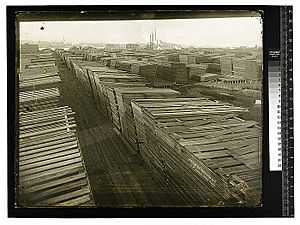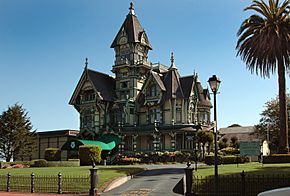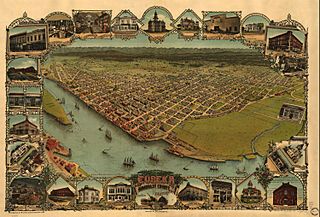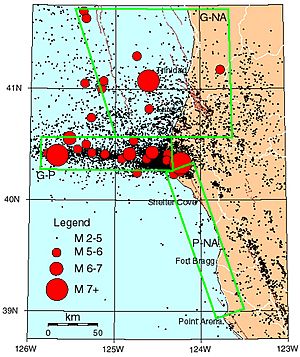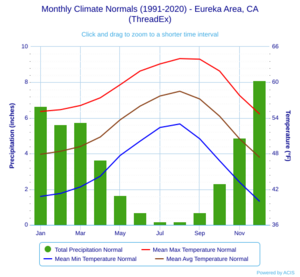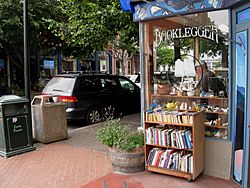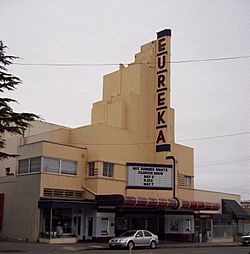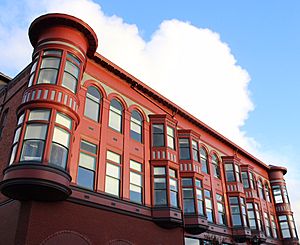Eureka, California facts for kids
Quick facts for kids
Eureka, California
|
|||
|---|---|---|---|
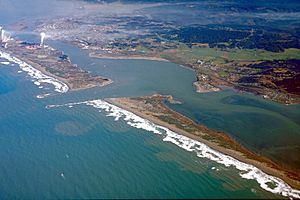
Aerial view: Eureka on Humboldt Bay
|
|||
|
|||
| Motto(s):
Eureka! (I have found it!)
|
|||
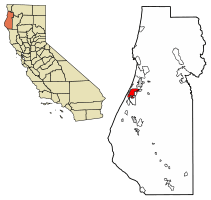
Location within Humboldt County
|
|||
| Country | United States | ||
| State | California | ||
| County | Humboldt | ||
| Founded | May 13, 1850 | ||
| Incorporated (town) | April 18, 1856 | ||
| Re-incorporated (city) | February 19, 1874 | ||
| Government | |||
| • Type | Council-Manager | ||
| Area | |||
| • City | 14.45 sq mi (37.43 km2) | ||
| • Land | 9.38 sq mi (24.30 km2) | ||
| • Water | 5.07 sq mi (13.13 km2) 35.07% | ||
| • Urban | 18.498 sq mi (47.908 km2) | ||
| Elevation | 39 ft (12 m) | ||
| Population
(2020)
|
|||
| • City | 26,512 | ||
| • Density | 2,846.33/sq mi (1,098.96/km2) | ||
| • Urban | 48,119 | ||
| Demonym(s) | Eurekan | ||
| Time zone | UTC−8 (Pacific) | ||
| • Summer (DST) | UTC−7 (PDT) | ||
| ZIP Codes |
95501–95503, 95534
|
||
| Area code | 707 | ||
| FIPS code | 06-23042 | ||
| GNIS feature IDs | 277605, 2410463 | ||
| Reference #: | 477 | ||
Eureka (pronounced "yuurr-EE-kuh") is a city in California. It's the main city of Humboldt County. You can find it on the North Coast of California, right on U.S. Route 101. The city sits by the beautiful Humboldt Bay. It's about 270 miles (435 km) north of San Francisco. It's also about 100 miles (161 km) south of the Oregon border.
In 2020, about 26,512 people lived in Eureka. The larger area around Eureka had about 48,119 people. Eureka is the biggest coastal city between San Francisco and Portland, Oregon. It's also the westernmost city with over 25,000 people in the main 48 states.
Because it's so close to the ocean, Eureka has a very mild climate. Temperatures don't change much throughout the year. The seasons are mostly defined by rainy winters and dry, cool summers. Eureka is a key spot for government, health care, and arts on the North Coast. It's also one of California's main commercial fishing ports. It has the largest deep-water port between San Francisco and Coos Bay.
Eureka is home to the main offices for both the Six Rivers National Forest and the North Coast Redwoods District of the California State Parks System. The city was once a major center for the West Coast lumber trade. It's a state historic landmark with many amazing Victorian homes. This includes the famous Carson Mansion. Its old downtown area, called Old Town, is a nationally recognized Historic District. Eureka also has California's oldest zoo, the Sequoia Park Zoo.
Contents
Exploring Eureka's Past
Native American Heritage
The Wiyot people lived in the area now known as Eureka for thousands of years. They called their home Jaroujiji. Their land stretched from the lower Mad River to Humboldt Bay. It also went south along the lower Eel River. The Wiyot were skilled at making baskets and managing fisheries. You can see many of their beautiful baskets at the Clarke Historical Museum in Old Town Eureka.
As of 2013, Eureka High School has the biggest Yurok language program in California. The Wiyot and Yurok are the westernmost groups who speak Algic languages.
How Eureka Was Founded
For almost 300 years, European explorers missed finding Humboldt Bay. This was due to the bay's hidden entrance and the weather. Even after a Russian sighting in 1806, the bay wasn't truly known until 1849. That year, an overland trip finally mapped its exact location. This led to Eureka being founded on May 13, 1850. It was started by the Union and Mendocino Exploring companies.
Gold Rush Days
After the main California Gold Rush, people settled Humboldt Bay. They wanted to create an easier way to supply miners. These miners were searching for gold on the Trinity, Klamath, and Salmon Rivers. Eureka's location on Humboldt Bay helped it grow into the main city. However, Arcata was closer to the gold mines. So, Arcata was more important until 1856.
The name "Eureka" comes from a Greek word. It means "I have found it!" This was a happy shout from gold miners. It's also the official motto of California. Eureka is the only U.S. city that uses the same seal as its state.
Impact on Native Americans
When Europeans arrived, they met the Wiyot people. After 1850, American settlers took over the Wiyot lands. The Wiyot had lived there for centuries. Settlers often cut off the Wiyot's access to their traditional food sources. They also took their land. Some U.S. officials tried to help or keep peace.
Fort Humboldt was built in 1853. It was meant to be a buffer between Native Americans, gold-seekers, and settlers. In 1860, a terrible event happened on Indian Island. A group of local people attacked the Wiyot. Many Wiyot children, women, and elders were killed. This event is known as the 1860 Wiyot Massacre.
The Lumber Industry Boom
Eureka's first post office opened in 1853. The town began to grow into the surrounding forest. This forest would later be used to build cities like San Francisco. Many early settlers were also lumbermen. They quickly saw the huge potential for the timber industry. By 1854, most of the mills on Humboldt Bay were in Eureka.
A year later, 140 lumber ships were moving timber from Eureka. They shipped it to growing cities along the Pacific coast. By 1856, mills in Eureka could produce 220,000 board feet of lumber daily. This huge production continued for over a century. It made Eureka the "timber capital" of California.
Eureka was perfectly located between huge coast redwood forests and the main port. Loggers cut down the giant redwood trees. Trains carried logs and lumber to Eureka's wharf. From there, ships took the products away. By the 1880s, railroads brought lumber from many mills to Eureka. This made Eureka a very important city in early California history.
A Thriving Commercial Center
A busy downtown area grew near the waterfront. It had fancy Victorian-style buildings. These buildings showed the city's wealth. Hundreds of these Victorian homes still stand today. Many have been restored to their original beauty. These homes are very important to Victorian architecture in the U.S.
The amazing Carson Mansion is one of the most famous Victorian homes. It was built between 1884 and 1886. Famous architects Newsom and Newsom designed it. They built it for lumber owner William M. Carson. This project kept mill workers busy during a slow time.
Old Town Eureka was the city's original downtown. It has been restored and is now a lively arts area. Old Town is a Historic District on the National Register of Historic Places. It has over 150 buildings from Eureka's 19th-century past. Today, Old Town still has many Victorian buildings. Some are still shops or homes. Others are unique hotels, restaurants, and small stores. They sell handmade items and local art.
Fishing, Shipping, and Boating
Eureka's growth has always been connected to Humboldt Bay and the Pacific Ocean. Fishing was a very important industry. Salmon fisheries started on the Eel River in 1851. By 1858, thousands of pounds of fish were shipped from Eureka's wharf each year.
The first ship built in Eureka was launched in 1858. This started a shipbuilding industry that lasted for many years. Humboldt Bay is also home to the West Coast's largest oyster farms. These farms began in the 1800s.
Today, Eureka is home to over 100 fishing boats. They are docked in two modern marinas. These marinas can hold about 400 boats. Fish caught here include salmon, tuna, Dungeness crab, and shrimp. In 1981, over 36 million pounds (16 million kg) of fish were caught.
Chinese Community Expulsion
In the late 1800s, many people had unfair views of Chinese immigrants. This led to attacks on them across the West. In February 1885, a city councilman was killed in Eureka. After this, a group of about 600 local people forced all 480 Chinese residents to leave Eureka. They were not allowed to return. This rule against Chinese people was removed in 1959.
The "Queen City" Era
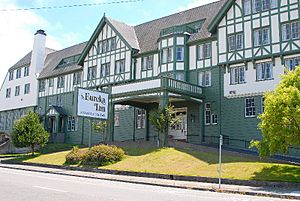
In 1914, the Northwestern Pacific Railroad was finished. This gave the lumber industry a new way to transport wood. It also created the first safe land route for people to travel between San Francisco and Eureka. As a result, Eureka's population grew from 7,300 to 15,000 in ten years.
By 1922, the Redwood Highway was completed. This allowed cars to travel directly from San Francisco. By 1931, Eureka had 15 streetcars on 12 miles (19 km) of track. Traveling to Eureka became much easier. The famous Eureka Inn was built when the new road opened. Because of this growth, Eureka called itself the "Queen City of the Ultimate West." This was the start of tourism in the area.
Modern Times: After World War II
After World War II, both the timber and fishing industries in Eureka slowed down. In 1962, a big storm caused many trees to fall. This led to more timber being shipped to other countries. Log exports to Japan and other Pacific Rim nations grew.
In the 1970s and early 1980s, local fishing grew. Eureka fishermen caught more than half of the fish eaten in California. By 2010, about 100 to 120 commercial fishing boats called Eureka home. However, fishing has faced challenges, and some species are now overfished. Recreational fishing (for fun) has become more popular.
Oyster farming in Humboldt Bay has also changed. It produced a lot of oysters in the mid-1900s. By 2004, the amount harvested was smaller. However, oysters and oyster seeds are still sent from Humboldt Bay.
Earthquakes in Eureka
Eureka is in an area that often has large earthquakes. This is because it's near the Cascadia subduction zone and the San Andreas Fault. On December 20, 2022, a 6.4 magnitude earthquake hit near Ferndale. On January 9, 2010, a 6.5 magnitude earthquake happened off the coast. It caused things to fall and windows to break. Power went out in many areas.
The largest earthquake recorded here was a 7.2 magnitude event in 1980. These larger earthquakes can sometimes cause tsunamis along the coast.
Geography and Climate
Where Eureka Is Located
Eureka covers about 14.5 square miles (37.4 sq km). About 9.4 square miles (24.3 sq km) is land, and 5.1 square miles (13.1 sq km) is water.
Eureka is in California's Redwood Empire region. This area has the Pacific Ocean coast, Humboldt Bay, and several rivers. It's also home to Redwood National and State Parks. Eureka is on U.S. Route 101, about 283 miles (455 km) north of San Francisco.
The city's marina is on one of three islands in Humboldt Bay. The city spreads out from there, especially to the east. It goes into forests of Redwood and Douglas-fir trees. Most newer houses were built in areas where trees were previously cut.
The city blends into smaller nearby areas. Some newer homes are built on a golf course near forests. These homes were part of a plan to bring people closer to recreation. Beyond the city, you find hills and mountains that quickly rise over 2,000 feet (610 m).
Eureka is at a similar latitude to cities like New York City and Naples in Italy. However, those cities have much warmer summers. This shows how unique Eureka's climate is.
Eureka's Unique Climate
Eureka has a mild, cool-summer mediterranean climate. The Pacific Ocean and the cold Humboldt Bay keep temperatures cool. Winters are mild and rainy. Summers are mild, cool, and dry.
The average high in December (the coolest month) is 55.0°F (12.8°C). The average high in August (the warmest month) is 64.3°F (17.9°C). This is very mild for a city so far south. Eureka's summer temperatures are much cooler than cities like New York City. They are similar to places like Southeast Alaska or Scotland.
Temperatures don't change much between seasons. The difference between August and December average temperatures is only about 10.7°F (5.9°C). This is similar to how much the temperature changes in one day. Eureka is special because its record high temperature in February is warmer than in July or August. The highest temperature ever recorded in July is only 77°F (25°C).
The highest temperature ever recorded in Eureka is 87°F (31°C). The lowest is 20°F (-7°C). On average, the highest temperature each year is only 79°F (26°C). The lowest is about 29°F (-2°C). This means Eureka has a very small temperature range. It's the only city on the West Coast that has never reached 90°F (32°C).
Temperatures rarely drop to freezing at night. Daytime temperatures are usually mild, between 43°F (6°C) and 58°F (14°C). Eureka has never had a day where the temperature stayed below freezing.
Eureka gets about 40.3 inches (1024 mm) of rain each year. Most of the rain falls from October to April. December is usually the wettest month. Snowfall is very rare on the coast.
The area often has coastal fog, especially in summer. This fog and cool ocean breezes keep Eureka mild. Inland areas nearby can get much hotter, often over 100°F (38°C). This means Eureka can be 30-40°F (17-22°C) cooler than inland areas in summer. Despite the fog, Eureka gets a good amount of sunshine each year.
Population and People
| Historical population | |||
|---|---|---|---|
| Census | Pop. | %± | |
| 1860 | 612 | — | |
| 1870 | 2,049 | 234.8% | |
| 1880 | 2,639 | 28.8% | |
| 1890 | 4,858 | 84.1% | |
| 1900 | 7,327 | 50.8% | |
| 1910 | 11,845 | 61.7% | |
| 1920 | 12,923 | 9.1% | |
| 1930 | 15,752 | 21.9% | |
| 1940 | 17,055 | 8.3% | |
| 1950 | 23,058 | 35.2% | |
| 1960 | 28,137 | 22.0% | |
| 1970 | 24,337 | −13.5% | |
| 1980 | 24,153 | −0.8% | |
| 1990 | 27,025 | 11.9% | |
| 2000 | 26,128 | −3.3% | |
| 2010 | 27,191 | 4.1% | |
| 2020 | 26,512 | −2.5% | |
| U.S. Decennial Census 2010–2020 |
|||
| Racial and ethnic composition | 2000 | 2010 | 2020 |
|---|---|---|---|
| White (non-Hispanic) | 78.64% | 73.85% | 64.38% |
| Hispanic or Latino (of any race) | 7.77% | 11.56% | 15.14% |
| Two or more races (non-Hispanic) | 4.19% | 4.5% | 8.0% |
| Asian (non-Hispanic) | 3.44% | 4.13% | 5.53% |
| Native American (non-Hispanic) | 3.91% | 3.32% | 3.43% |
| Black or African American (non-Hispanic) | 1.53% | 1.83% | 1.91% |
| Pacific Islander (non-Hispanic) | 0.32% | 0.62% | 0.86% |
| Other (non-Hispanic) | 0.2% | 0.19% | 0.75% |
In 2010, Eureka had 27,191 people. This was a small increase from 2000. The larger Eureka area had 45,034 people in 2010.
The "Greater Eureka" area includes nearby neighborhoods. These areas have Eureka addresses and phone numbers. This larger area is the biggest urban settlement on the Pacific Coast between San Francisco and Portland.
What the 2010 Census Showed
The 2010 Census found that most people in Eureka were White (79.3%). About 11.6% of people were Hispanic or Latino. Other groups included African American, Native American, Asian, and Pacific Islander.
Most people (93.1%) lived in homes. About 25.9% of homes had children under 18. About 31.9% were married couples. The average household had 2.27 people.
About 20% of the population was under 18. About 11.8% were 65 or older. The average age was 36.2 years. For every 100 females, there were about 106 males.
Eureka's Economy
Eureka's economy started with timber, fishing, and supplying gold miners. Gold mining quickly faded. Timber and fishing also became less important later in the 1900s.
Today, the main industries are tourism, timber (by value), and healthcare and services (by number of jobs). Major employers include College of the Redwoods, Humboldt County, and the Humboldt County Office of Education. St. Joseph Hospital is the largest private employer in Eureka.
City Services and Transport
Getting Around Eureka
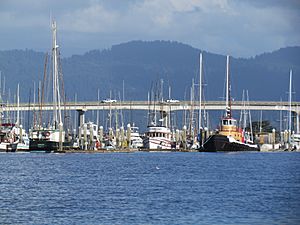
Roads
![]() U.S. Route 101 is the main highway. It runs north and south, connecting Eureka to Oregon (100 miles north) and San Francisco (250 miles south). The highway goes through Eureka's streets.
U.S. Route 101 is the main highway. It runs north and south, connecting Eureka to Oregon (100 miles north) and San Francisco (250 miles south). The highway goes through Eureka's streets.
![]() State Route 255 is another route. It connects Eureka to Arcata along Humboldt Bay.
State Route 255 is another route. It connects Eureka to Arcata along Humboldt Bay.
![]() State Route 299 connects to U.S. Route 101 in Arcata. It then goes east, serving as a major road for Eureka.
State Route 299 connects to U.S. Route 101 in Arcata. It then goes east, serving as a major road for Eureka.
Air Travel
Eureka's main airport is the Arcata-Eureka Airport. It's about 15 miles (24 km) north in McKinleyville. You can fly from here to San Francisco, Los Angeles, Denver, and Burbank. Murray Field and Eureka Municipal Airport are smaller airports for private planes.
Water Travel
The Humboldt Bay Harbor Recreation & Conservation District manages Humboldt Bay. This includes the deep-water port. The port has docks for large ships. There are also several modern marinas for smaller boats. They can hold over 400 boats.
Bus Services
The Eureka Transit Service provides local bus transportation. The Redwood Transit System offers buses through Eureka and to other towns. You can also get bus service to San Francisco with Greyhound.
A new project called the Eureka Regional Transit and Housing Center (EaRTH Center) is planned. It will improve bus connections and add affordable apartments. It should be finished in 2024.
City Utilities
Power and Gas
Pacific Gas and Electric Company provides electricity and natural gas. There are natural gas reserves south of the city. These fuels help power the Humboldt Bay Power Plant.
Water Supply
The City of Eureka gets its water from the Humboldt Bay Municipal Water District. This region has a lot of water. Because fewer factories are using water now, there's a large surplus.
Healthcare in Eureka
Eureka is the main healthcare center for the region. St. Joseph Hospital is the largest hospital north of the San Francisco Bay Area on the California Coast. It opened in 1920.
The hospital has been updated to meet earthquake safety rules. It has new surgery rooms, intensive care, and emergency care. It also has new patient rooms and facilities for assisted living.
In 2016, St. Joseph Health merged with Providence Health & Services. This made it part of a very large non-profit health system.
Eureka also has the only mental health emergency and hospitalization facilities north of San Francisco. Most doctors for specialized medical care are in or near Eureka. It also has the only cancer treatment program and dialysis clinic in the region.
Education in Eureka
For higher education, students can go to the College of the Redwoods or California State Polytechnic University, Humboldt in Arcata. College of the Redwoods also has a campus downtown.
Eureka City Schools manages the public schools. Eureka High School takes students from the city and nearby areas. Other schools include Alice Birney Elementary, Grant Elementary, Lafayette Elementary, Washington Elementary, Winship Middle School, and Zane Middle School. There are also other high schools and an adult school.
Shopping and Stores
The Bayshore Mall is the biggest shopping center north of the San Francisco Bay Area. It has over 70 stores and opened in 1987. Other major shopping areas include Henderson Center, the Eureka Mall, Burre Center, and Downtown and Old Town Eureka.
Arts and Culture
Eureka is a California historic landmark. Its Old Town is one of the best-preserved old commercial areas in the country. The city was named the No. 1 best small art town in a book called The 100 Best Small Art Towns in America. Many buildings in downtown Eureka are decorated with murals.
Eureka hosts "Arts' Alive!" every first Saturday of the month. Over 80 businesses and galleries open their doors. You can often enjoy local food, drinks, and live music.
In the summer, Eureka has Friday Night Markets in Old Town. These markets feature local artists, food trucks, and musicians.
You can also find theater shows year-round. Groups like the North Coast Repertory Theater perform here. Various events happen at the Redwood Acres Fairgrounds.
Fun Annual Events
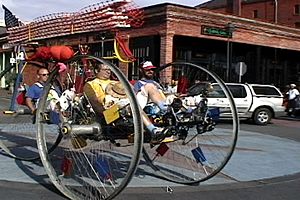
- Redwood Coast Music Festival – October
- Rhododendron Festival – April
- Kinetic sculpture race – May (a famous race of human-powered art!)
- Redwood Acres Fair and Rodeo – June
- Summer Concert Series on the Boardwalk – June – August
- Fourth of July Celebration – July
- Humboldt Bay Full of Blues – August
- Excalibur Medieval Tournament and Market Faire – September
- Pride Parade and Celebration – September
- Christmas Truckers Parade – December
Museums and Art Spots
Eureka has many museums and galleries. These include the Clarke Historical Museum, the Humboldt Bay Maritime Museum, and the Morris Graves Museum of Art. You can also visit the Kinetic Museum, Discovery Museum for Children, and the Fort Humboldt State Historic Park.
Amazing Architecture
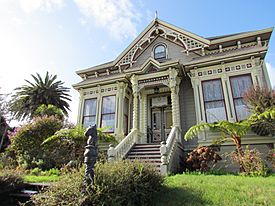
Eureka has many old buildings. This is because it didn't have a lot of new construction in the late 1900s. So, you can see hundreds of buildings from the 1800s and early 1900s.
About 16% of the city's buildings are important historical structures. Many are famous examples of their architectural style. Thirteen areas in Eureka are listed on the National Register of Historic Places. These include the 2nd Street District and Old Town. In total, about 1,500 buildings could be on the National Register. The Eureka Heritage Society helps protect these old buildings.
Parks and Fun Activities
Sequoia Park Zoo has Eureka's largest public playground and a duck pond. It also has gardens and many types of rhododendron bushes. The zoo is on over 67 acres (27 hectares) of redwood forest. It has a Sky Walk that lets you see the forest from high up in the trees.
The City of Eureka Recreation Department manages 13 playgrounds. This includes Cooper Gulch, which is 33 acres (13 hectares). They also manage tennis courts, basketball courts, and soccer fields.
Other parks near Eureka include the Humboldt Botanical Garden and the Humboldt Bay National Wildlife Refuge. The Eureka Marsh is a protected marsh area you can visit. There's also a modern boardwalk along the city's waterfront. The Hikshari' Trail is a paved path for walking and biking along the coast. It has cool art installations.
Media and News
Eureka has one main daily newspaper, the Times-Standard. It prints about 13,000 papers daily and publishes online on Mondays. The Lost Coast Outpost is a local online news source. The North Coast Journal is a weekly newspaper that moved to Eureka in 2009.
Many radio stations are based in Eureka. These include KINS-FM, KWSW, and KEKA-FM. There are also community radio stations. Eureka's first TV station, KIEM, started broadcasting in 1953.
Sister Cities
 Singkawang, West Kalimantan, Indonesia
Singkawang, West Kalimantan, Indonesia Kamisu, Japan: Kamisu, Japan, has been Eureka's official Sister City since 1991. Both cities had similar populations and bays. They have had cultural exchanges since 1991. In 2019, Eureka named a park after its sister city.
Kamisu, Japan: Kamisu, Japan, has been Eureka's official Sister City since 1991. Both cities had similar populations and bays. They have had cultural exchanges since 1991. In 2019, Eureka named a park after its sister city.
Famous People from Eureka
See also
 In Spanish: Eureka (California) para niños
In Spanish: Eureka (California) para niños





